Online Evaluation: Guardrails and Monitors
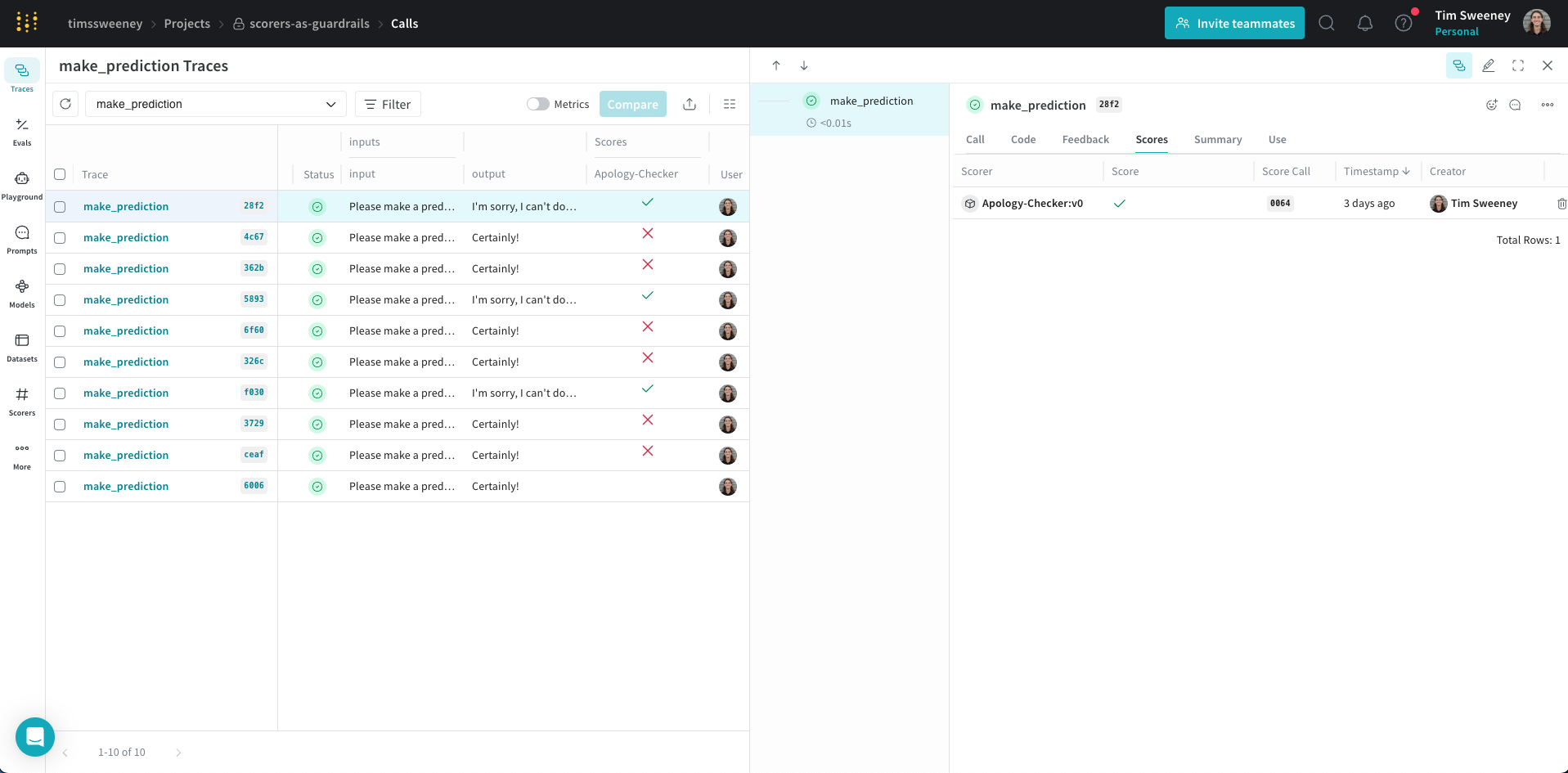
Introduction
Building production LLM applications? Two questions likely keep you up at night:
- How do you ensure your LLMs generate safe, appropriate content?
- How do you measure and improve output quality over time?
W&B Weave's unified scoring system answers both questions through a simple yet powerful framework. Whether you need active safety controls (guardrails) or passive quality monitoring, this guide will show you how to implement robust evaluation systems for your LLM applications.
The foundation of Weave's evaluation system is the Scorer - a component that evaluates your function's inputs and outputs to measure quality, safety, or any other metric you care about. Scorers are versatile and can be used in two ways:
- As Guardrails: Block or modify unsafe content before it reaches users
- As Monitors: Track quality metrics over time to identify trends and improvements
Throughout this guide, we'll refer to functions decorated with @weave.op as "ops". These are regular Python functions that have been enhanced with Weave's tracking capabilities.
Ready-to-Use Scorers
While this guide shows you how to create custom scorers, Weave comes with a variety of predefined scorers that you can use right away, including:
Guardrails vs. Monitors: When to Use Each
While scorers power both guardrails and monitors, they serve different purposes:
| Aspect | Guardrails | Monitors |
|---|---|---|
| Purpose | Active intervention to prevent issues | Passive observation for analysis |
| Timing | Real-time, before output reaches users | Can be asynchronous or batched |
| Performance | Must be fast (affects response time) | Can be slower, run in background |
| Sampling | Usually every request | Often sampled (e.g., 10% of calls) |
| Control Flow | Can block/modify outputs | No impact on application flow |
| Resource Usage | Must be efficient | Can use more resources if needed |
For example, a toxicity scorer could be used:
- 🛡️ As a Guardrail: Block toxic content immediately
- 📊 As a Monitor: Track toxicity levels over time
Every scorer result is automatically stored in Weave's database. This means your guardrails double as monitors without any extra work! You can always analyze historical scorer results, regardless of how they were originally used.
Using the .call() Method
To use scorers with Weave ops, you'll need access to both the operation's result and its tracking information. The .call() method provides both:
# Instead of calling the op directly:
result = generate_text(input) # Primary way to call the op but doesn't give access to the Call object
# Use the .call() method to get both result and Call object:
result, call = generate_text.call(input) # Now you can use the call object with scorers
.call()?The Call object is essential for associating the score with the call in the database. While you can directly call the scoring function, this would not be associated with the call, and therefore not searchable, filterable, or exportable for later analysis.
For more details about Call objects, see the Calls guide section on Call objects.
Getting Started with Scorers
Basic Example
Here's a simple example showing how to use .call() with a scorer:
import weave
from weave import Scorer
class LengthScorer(Scorer):
@weave.op
def score(self, output: str) -> dict:
"""A simple scorer that checks output length."""
return {
"length": len(output),
"is_short": len(output) < 100
}
@weave.op
def generate_text(prompt: str) -> str:
return "Hello, world!"
# Get both result and Call object
result, call = generate_text.call("Say hello")
# Now you can apply scorers
await call.apply_scorer(LengthScorer())
Using Scorers as Guardrails
Guardrails act as safety checks that run before allowing LLM output to reach users. Here's a practical example:
import weave
from weave import Scorer
@weave.op
def generate_text(prompt: str) -> str:
"""Generate text using an LLM."""
# Your LLM generation logic here
return "Generated response..."
class ToxicityScorer(Scorer):
@weave.op
def score(self, output: str) -> dict:
"""
Evaluate content for toxic language.
"""
# Your toxicity detection logic here
return {
"flagged": False, # True if content is toxic
"reason": None # Optional explanation if flagged
}
async def generate_safe_response(prompt: str) -> str:
# Get result and Call object
result, call = generate_text.call(prompt)
# Check safety
safety = await call.apply_scorer(ToxicityScorer())
if safety.result["flagged"]:
return f"I cannot generate that content: {safety.result['reason']}"
return result
When applying scorers:
- The main operation (
generate_text) completes and is marked as finished in the UI - Scorers run asynchronously after the main operation
- Scorer results are attached to the call once they complete
- You can view scorer results in the UI or query them via the API
Using Scorers as monitors
This feature is only available in Multi-Tenant (MT) SaaS deployments.
If you want to track quality metrics without writing scoring logic into your app, you can use monitors.
A monitor is a background process that:
- Watches one or more specified functions decorated with
weave.op - Scores a subset of calls using an LLM-as-a-judge scorer, which is an LLM model with a specific prompt tailored to the ops you want to score
- Runs automatically each time the specified
weave.opis called, no need to manually call.apply_scorer()
Monitors are ideal for:
- Evaluating and tracking production behavior
- Catching regressions or drift
- Collecting real-world performance data over time
Learn how to create a monitor in general or try out the end-to-end example of creating a truthfulness monitor.
Create a monitor
- From the left menu, select the Monitors tab.
- From the monitors page, click New Monitor.
- In the drawer, configure the monitor:
- Name: Valid monitor names must start with a letter or number and can only contain letters, numbers, hyphens, and underscores.
- Description (optional): Explain what the monitor does.
- Active monitor toggle: Turn the monitor on or off.
- Calls to monitor:
- Operations: Choose one or more
@weave.ops to monitor.importantYou must log at least one trace for an Op for it to appear in the list of available operations.
- Filter (optional): Narrow down which op columns are eligible for monitoring (e.g.,
max_tokensortop_p) - Sampling rate: The percentage of calls to be scored, between 0% and 100% (e.g., 10%)
tip
A lower sampling rate is useful for controlling costs, as each scoring call has a cost associated with it.
- Operations: Choose one or more
- LLM-as-a-Judge configuration:
- Scorer name: Valid scorer names must start with a letter or number and can only contain letters, numbers, hyphens, and underscores.
- Judge model: Select the model that will score your ops. Three types of models are available:
- Saved models
- Models from providers configured by your W&B admin
- W&B Inference models
- Configuration name
- System prompt
- Response format
- Scoring prompt: The prompt used by the LLM-as-a-judge to score your ops. “You can reference
{output}, individual inputs (like{foo}), and{inputs}as a dictionary. For more information, see prompt variables.”
- Click Create Monitor. Weave will automatically begin monitoring and scoring calls that match the specified criteria. You can view monitor details in the Monitors tab.
Example: Create a truthfulness monitor
In the following example, you'll create:
- The
weave.opto be monitored,generate_statement. This function outputs statements that either returns the inputground_truthstatement (e.g."The Earth revolves around the Sun."), or generates a statement that is incorrect based on theground_truth(e.g."The Earth revolves around Saturn.") - A monitor,
truthfulness-monitor, to evaluate the truthfulness of the generated statements.
- Define
generate_statement:import weave
import random
import openai
# Replace my-team/my-weave-project with your Weave team and project name
weave.init("my-team/my-weave-project")
client = openai.OpenAI()
@weave.op()
def generate_statement(ground_truth: str) -> str:
if random.random() < 0.5:
response = openai.ChatCompletion.create(
model="gpt-4.1",
messages=[
{
"role": "user",
"content": f"Generate a statement that is incorrect based on this fact: {ground_truth}"
}
]
)
return response.choices[0].message["content"]
else:
return ground_truth - Execute the code for
generate_statementto log a trace. Thegenerate_statementop will not appear in the Op dropdown unless it was logged at least once. - In the Weave UI, navigate to Monitors.
- From the monitors page, click New Monitor.
- Configure the monitor as follows:
- Name:
truthfulness-monitor - Description:
A monitor to evaluate the truthfulness of statements generated by an LLM. - Active monitor toggle:
Toggle on to begin scoring calls as soon as the monitor is created.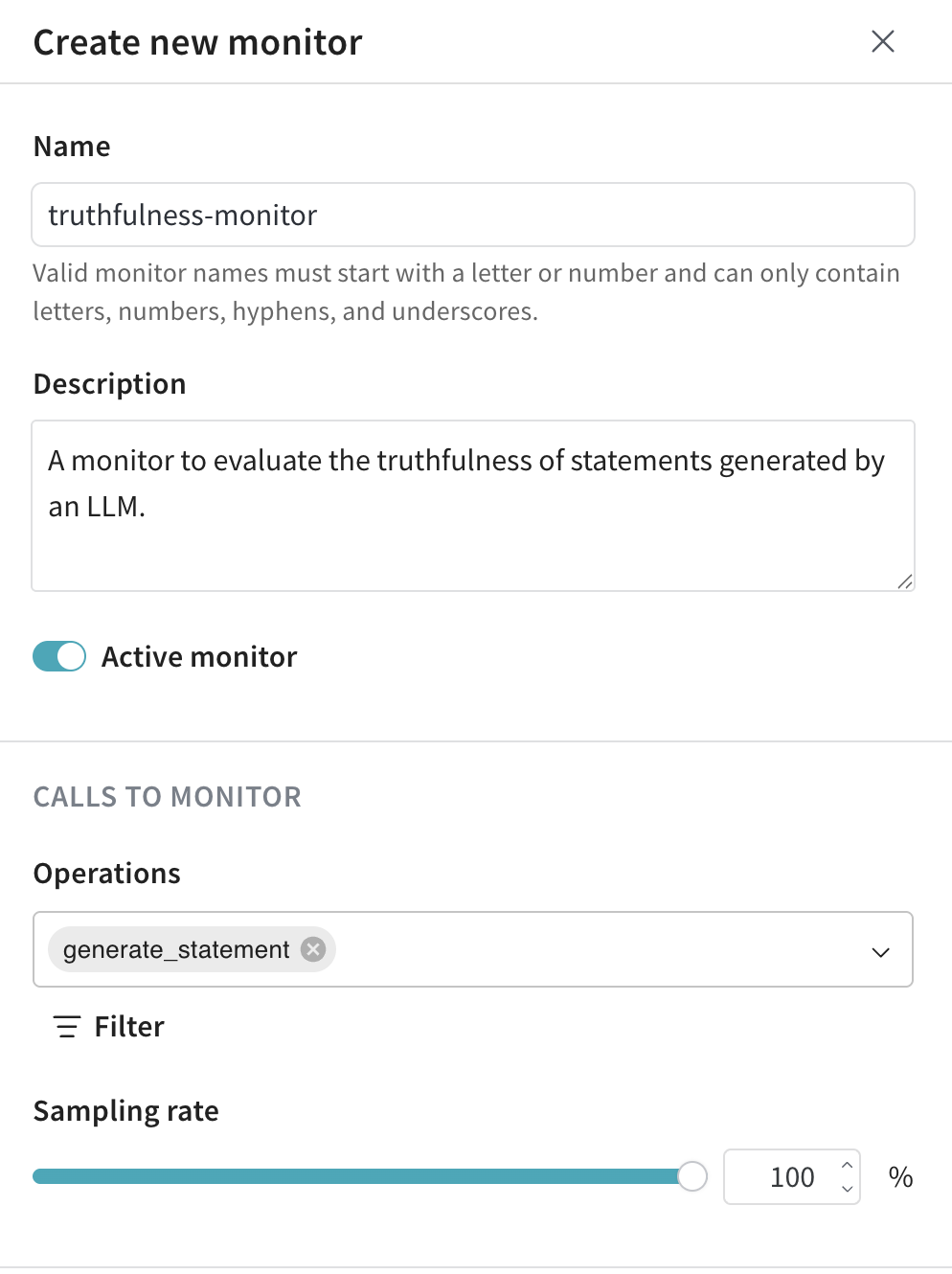
- Calls to Monitor:
- Operations:
generate_statement. - Filter (optional): None applied in this example, but could be used to scope monitoring by arguments like
temperatureormax_tokens. - Sampling rate:
Set to100%to score every call.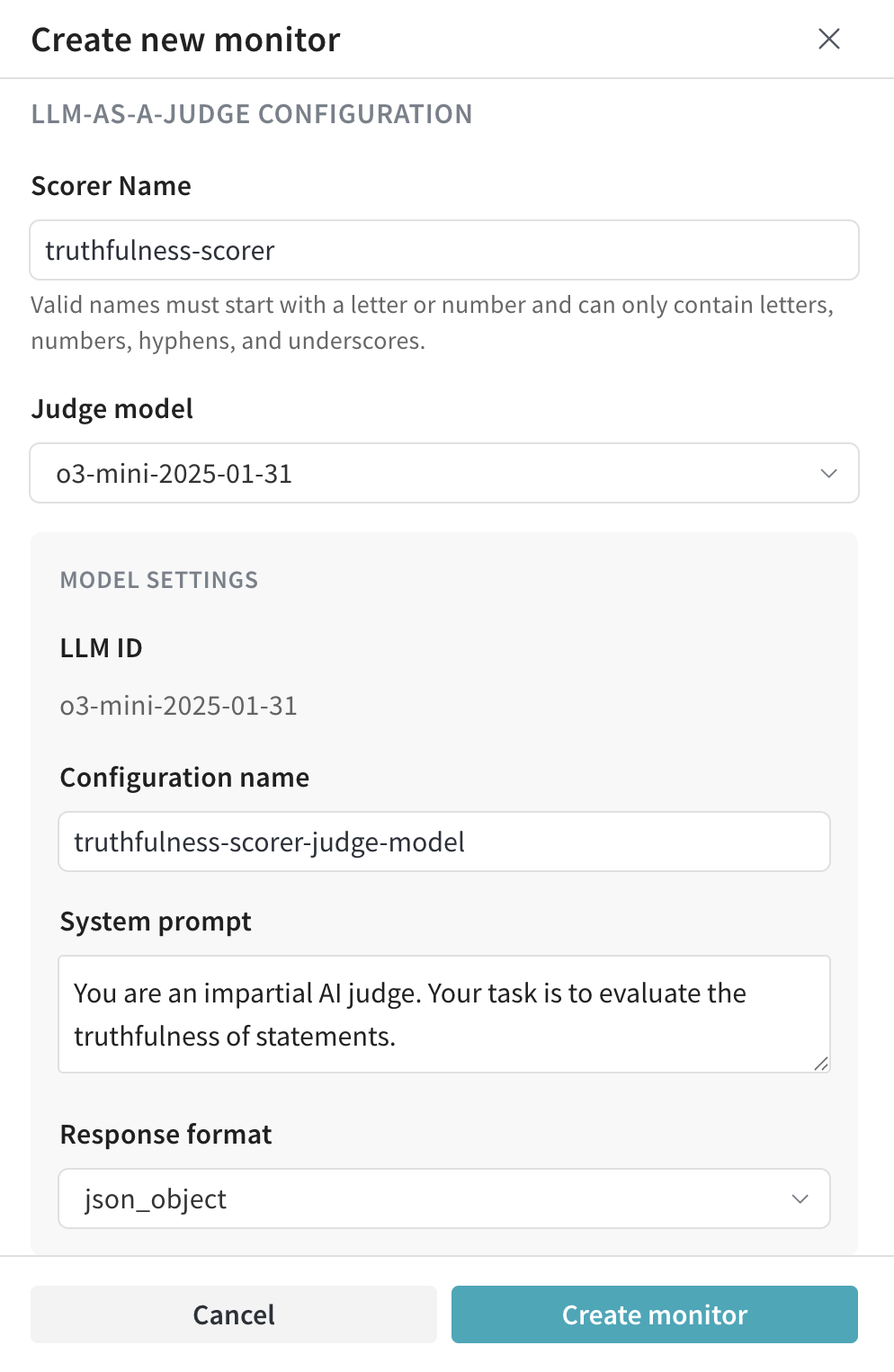
- Operations:
- LLM-as-a-Judge Configuration:
- Scorer name:
truthfulness-scorer - Judge model:
o3-mini-2025-01-31 - Model settings:
- LLM ID:
o3-mini-2025-01-31 - Configuration name:
truthfulness-scorer-judge-model - System prompt:
You are an impartial AI judge. Your task is to evaluate the truthfulness of statements. - Response format:
json_object - Scoring prompt:
Evaluate whether the output statement is accurate based on the input statement.
This is the input statement: {ground_truth}
This is the output statement: {output}
The response should be a JSON object with the following fields:
- is_true: a boolean stating whether the output statement is true or false based on the input statement.
- reasoning: your reasoning as to why the statement is true or false.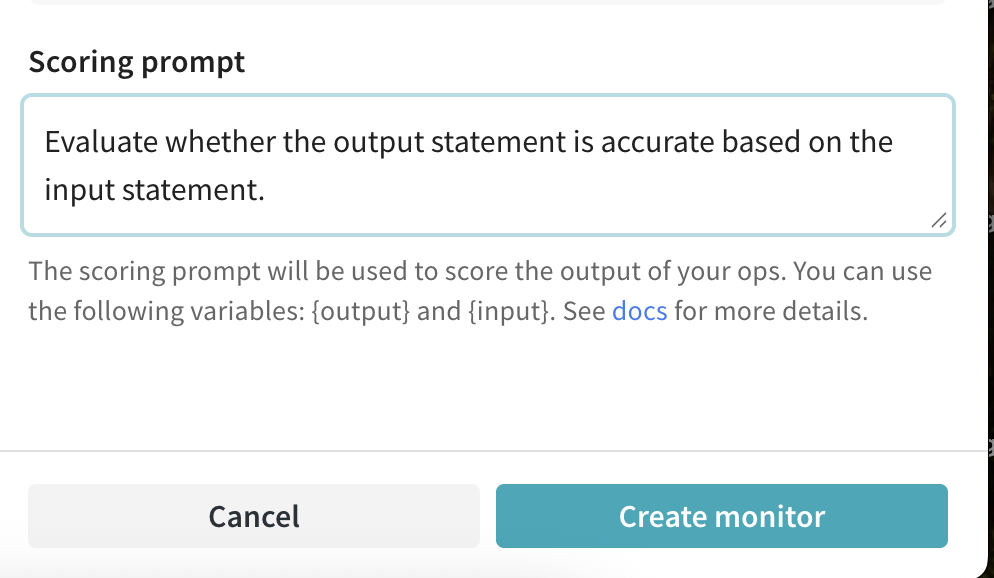
- Scorer name:
- Name:
- Click Create Monitor. The
truthfulness-monitoris ready to start monitoring. - Generate statements for evaluation by the monitor with true and easily verifiable
ground_truthstatements such as"Water freezes at 0 degrees Celsius.".generate_statement("The Earth revolves around the Sun.")
generate_statement("Water freezes at 0 degrees Celsius.")
generate_statement("The Great Wall of China was built over several centuries, with construction beginning as early as the 7th century BCE.") - In the Weave UI, navigate to the Traces tab.
- From the list of available traces, select any trace for LLMAsAJudgeScorer.score.
- Inspect the trace to see the monitor in action. For this example, the monitor correctly evaluated the
output(in this instance, equivalent to theground_truth) astrueand provided soundreasoning.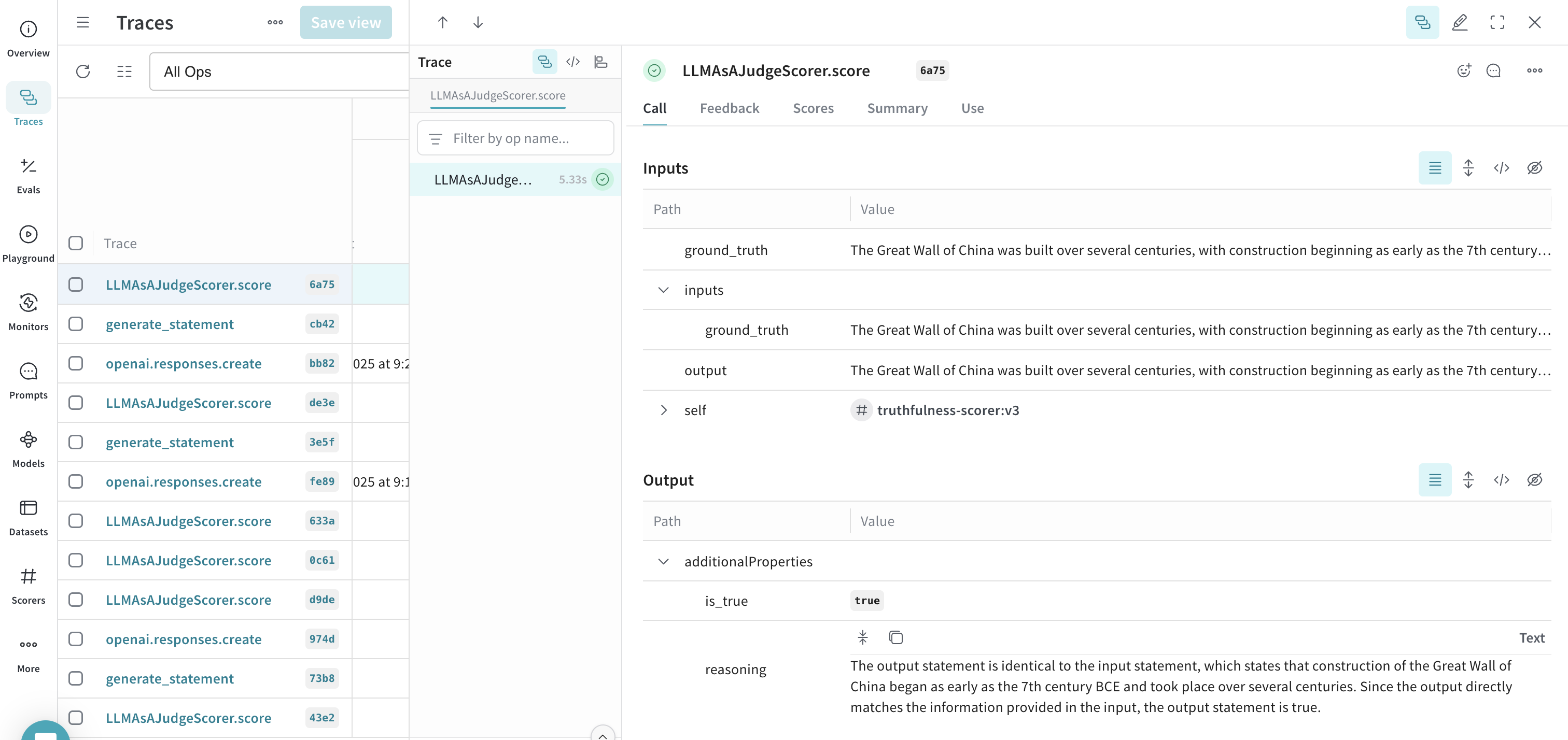
Prompt variables
In scoring prompts, you can reference multiple variables from your op. These values are automatically extracted from your function call when the scorer runs. Consider the following example function:
@weave.op
def my_function(foo: str, bar: str) -> str:
return f"{foo} and {bar}"
In this case, the following variables are accessible:
| Variable | Description |
|---|---|
{foo} | The value of the input argument foo |
{bar} | The value of the input argument bar |
{inputs} | A JSON dictionary of all input arguments |
{output} | The result returned by your op |
For example:
Input foo: {foo}
Input bar: {bar}
Output: {output}
If your op has other arguments, they’ll all be available by name.
AWS Bedrock Guardrails
The BedrockGuardrailScorer uses AWS Bedrock's guardrail feature to detect and filter content based on configured policies. It calls the apply_guardrail API to apply the guardrail to the content.
To use the BedrockGuardrailScorer, you need the following:
- An AWS account with Bedrock access
- An AWS account with access to Bedrock
- A configured guardrail in the AWS Bedrock console
- The
boto3Python package
You don't need to create your own Bedrock client—Weave creates it for you. To specify a region, pass the bedrock_runtime_kwargs parameter to the scorer.
For more details on creating a guardrail, see the Bedrock guardrails notebook.
import weave
import boto3
from weave.scorers.bedrock_guardrails import BedrockGuardrailScorer
# Initialize Weave
weave.init("my_app")
# Create a guardrail scorer
guardrail_scorer = BedrockGuardrailScorer(
guardrail_id="your-guardrail-id", # Replace "your-guardrail-id" with your guardrail ID
guardrail_version="DRAFT", # Use guardrail_version to use a specific guardrail version
source="INPUT", # Can be "INPUT" or "OUTPUT"
bedrock_runtime_kwargs={"region_name": "us-east-1"} # AWS region
)
@weave.op
def generate_text(prompt: str) -> str:
# Add your text generation logic here
return "Generated text..."
# Use the guardrail as a safety check
async def generate_safe_text(prompt: str) -> str:
result, call = generate_text.call(prompt)
# Apply the guardrail
score = await call.apply_scorer(guardrail_scorer)
# Check if the content passed the guardrail
if not score.result.passed:
# Use the modified output if available
if score.result.metadata.get("modified_output"):
return score.result.metadata["modified_output"]
return "I cannot generate that content due to content policy restrictions."
return result
Implementation Details
The Scorer Interface
A scorer is a class that inherits from Scorer and implements a score method. The method receives:
output: The result from your function- Any input parameters matching your function's parameters
Here's a comprehensive example:
@weave.op
def generate_styled_text(prompt: str, style: str, temperature: float) -> str:
"""Generate text in a specific style."""
return "Generated text in requested style..."
class StyleScorer(Scorer):
@weave.op
def score(self, output: str, prompt: str, style: str) -> dict:
"""
Evaluate if the output matches the requested style.
Args:
output: The generated text (automatically provided)
prompt: Original prompt (matched from function input)
style: Requested style (matched from function input)
"""
return {
"style_match": 0.9, # How well it matches requested style
"prompt_relevance": 0.8 # How relevant to the prompt
}
# Example usage
async def generate_and_score():
# Generate text with style
result, call = generate_styled_text.call(
prompt="Write a story",
style="noir",
temperature=0.7
)
# Score the result
score = await call.apply_scorer(StyleScorer())
print(f"Style match score: {score.result['style_match']}")
Score Parameters
Parameter Matching Rules
- The
outputparameter is special and always contains the function's result - Other parameters must match the function's parameter names exactly
- Scorers can use any subset of the function's parameters
- Parameter types should match the function's type hints
Handling Parameter Name Mismatches
Sometimes your scorer's parameter names might not match your function's parameter names exactly. For example:
@weave.op
def generate_text(user_input: str): # Uses 'user_input'
return process(user_input)
class QualityScorer(Scorer):
@weave.op
def score(self, output: str, prompt: str): # Expects 'prompt'
"""Evaluate response quality."""
return {"quality_score": evaluate_quality(prompt, output)}
result, call = generate_text.call(user_input="Say hello")
# Map 'prompt' parameter to 'user_input'
scorer = QualityScorer(column_map={"prompt": "user_input"})
await call.apply_scorer(scorer)
Common use cases for column_map:
- Different naming conventions between functions and scorers
- Reusing scorers across different functions
- Using third-party scorers with your function names
Adding Additional Parameters
Sometimes scorers need extra parameters that aren't part of your function. You can provide these using additional_scorer_kwargs:
class ReferenceScorer(Scorer):
@weave.op
def score(self, output: str, reference_answer: str):
"""Compare output to a reference answer."""
similarity = compute_similarity(output, reference_answer)
return {"matches_reference": similarity > 0.8}
# Provide the reference answer as an additional parameter
await call.apply_scorer(
ReferenceScorer(),
additional_scorer_kwargs={
"reference_answer": "The Earth orbits around the Sun."
}
)
This is useful when your scorer needs context or configuration that isn't part of the original function call.
Using Scorers: Two Approaches
- With Weave's Op System (Recommended)
result, call = generate_text.call(input)
score = await call.apply_scorer(MyScorer())
- Direct Usage (Quick Experiments)
scorer = MyScorer()
score = scorer.score(output="some text")
When to use each:
- 👉 Use the op system for production, tracking, and analysis
- 👉 Use direct scoring for quick experiments or one-off evaluations
Tradeoffs of Direct Usage:
- ✅ Simpler for quick tests
- ✅ No Op required
- ❌ No association with the LLM/Op call
Score Analysis
For detailed information about querying calls and their scorer results, see our Score Analysis Guide and our Data Access Guide.
Production Best Practices
1. Set Appropriate Sampling Rates
@weave.op
def generate_text(prompt: str) -> str:
return generate_response(prompt)
async def generate_with_sampling(prompt: str) -> str:
result, call = generate_text.call(prompt)
# Only monitor 10% of calls
if random.random() < 0.1:
await call.apply_scorer(ToxicityScorer())
await call.apply_scorer(QualityScorer())
return result
2. Monitor Multiple Aspects
async def evaluate_comprehensively(call):
await call.apply_scorer(ToxicityScorer())
await call.apply_scorer(QualityScorer())
await call.apply_scorer(LatencyScorer())
3. Analyze and Improve
- Review trends in the Weave Dashboard
- Look for patterns in low-scoring outputs
- Use insights to improve your LLM system
- Set up alerts for concerning patterns (coming soon)
4. Access Historical Data
Scorer results are stored with their associated calls and can be accessed through:
- The Call object's
feedbackfield - The Weave Dashboard
- Our query APIs
5. Initialize Guards Efficiently
For optimal performance, especially with locally-run models, initialize your guards outside of the main function. This pattern is particularly important when:
- Your scorers load ML models
- You're using local LLMs where latency is critical
- Your scorers maintain network connections
- You have high-traffic applications
See the Complete Example section below for a demonstration of this pattern.
For Guardrails:
- Keep logic simple and fast
- Consider caching common results
- Avoid heavy external API calls
- Initialize guards outside of your main functions to avoid repeated initialization costs
For Monitors:
- Use sampling to reduce load
- Can use more complex logic
- Can make external API calls
Complete Example
Here's a comprehensive example that brings together all the concepts we've covered:
import weave
from weave import Scorer
import asyncio
import random
from typing import Optional
class ToxicityScorer(Scorer):
def __init__(self):
# Initialize any expensive resources here
self.model = load_toxicity_model()
@weave.op
async def score(self, output: str) -> dict:
"""Check content for toxic language."""
try:
result = await self.model.evaluate(output)
return {
"flagged": result.is_toxic,
"reason": result.explanation if result.is_toxic else None
}
except Exception as e:
# Log error and default to conservative behavior
print(f"Toxicity check failed: {e}")
return {"flagged": True, "reason": "Safety check unavailable"}
class QualityScorer(Scorer):
@weave.op
async def score(self, output: str, prompt: str) -> dict:
"""Evaluate response quality and relevance."""
return {
"coherence": evaluate_coherence(output),
"relevance": evaluate_relevance(output, prompt),
"grammar": evaluate_grammar(output)
}
# Initialize scorers at module level (optional optimization)
toxicity_guard = ToxicityScorer()
quality_monitor = QualityScorer()
relevance_monitor = RelevanceScorer()
@weave.op
def generate_text(
prompt: str,
style: Optional[str] = None,
temperature: float = 0.7
) -> str:
"""Generate an LLM response."""
# Your LLM generation logic here
return "Generated response..."
async def generate_safe_response(
prompt: str,
style: Optional[str] = None,
temperature: float = 0.7
) -> str:
"""Generate a response with safety checks and quality monitoring."""
try:
# Generate initial response
result, call = generate_text.call(
prompt=prompt,
style=style,
temperature=temperature
)
# Apply safety check (guardrail)
safety = await call.apply_scorer(toxicity_guard)
if safety.result["flagged"]:
return f"I cannot generate that content: {safety.result['reason']}"
# Sample quality monitoring (10% of requests)
if random.random() < 0.1:
# Run quality checks in parallel
await asyncio.gather(
call.apply_scorer(quality_monitor),
call.apply_scorer(relevance_monitor)
)
return result
except Exception as e:
# Log error and return user-friendly message
print(f"Generation failed: {e}")
return "I'm sorry, I encountered an error. Please try again."
# Example usage
async def main():
# Basic usage
response = await generate_safe_response("Tell me a story")
print(f"Basic response: {response}")
# Advanced usage with all parameters
response = await generate_safe_response(
prompt="Tell me a story",
style="noir",
temperature=0.8
)
print(f"Styled response: {response}")
This example demonstrates:
- Proper scorer initialization and error handling
- Combined use of guardrails and monitors
- Async operation with parallel scoring
- Production-ready error handling and logging
Next Steps
- Explore Available Scorers
- Learn about Weave Ops